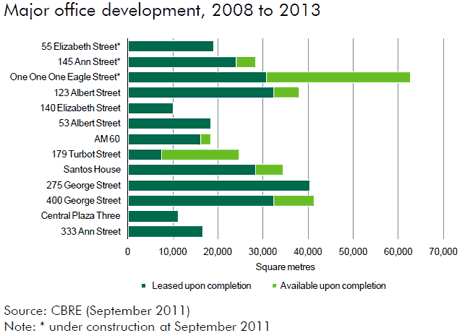Brisbane office market surges ahead, leaving Gold Coast in the dust

The economic recovery in Queensland is flowing through into surging demand for office space in the Brisbane CBD, but a recovery for the weak Gold Coast market is still some way off, according to research by CBRE.
Deloitte forecasts the Queensland economy to grow by an average of 5.3% between 2012 and 2106, driven by demand for commodities, nearly double the forecast growth rate of NSW (2.7%) and significantly higher than that forecast for the overall economy (3.4%).
In line with this resurgence, the Brisbane CBD office market has tightened to levels last seen in 2009, with rebounding white-collar employment and demand for space from the resources sector shrinking the overall vacancy from 9.4% to 7.4% in the six months to July 2011.
In the prime space, the vacancy rate stands at just 4%.
Over the six months to July 2011, the net absorption of office space was over 36,000 square metres, with prime gross rents around $750 per square metre mark and secondary rents just under $500 per square metre.
The vacancy rate is forecast to rise to 9.5% in the first half of 2012 as new stock comes on board, including GPT Group’s One One One Eagle Street, the 54-level premium-grade office tower on the Brisbane River, which will feature 64,000 square metres of office space.
ANZ, Ernst and Young, and law firms Gadens and Norton Rose have precommitted to an aggregate of 30,000 square metres of space in the new building.
Another building due for completion next year, Leighton Properties’ 27-storey, 28,000-square-metre King George Central A-grade office tower at 145 Ann Street, is 85% pre-committed.

CBRE is forecasting rental growth of approximately 4.4% per annum in the prime market and 2.2% in the secondary market until 2016.
“Substantial” demand for office space from the resources sector has caused the Brisbane vacancy rate to tighten far more quickly than previously anticipated, according to CBRE state director for office services David Prosser.
“There has been a noticeable flight to quality, which has resulted in a contraction in vacancy rates for Brisbane’s prime CBD office space,” he says.
“In addition, there is a limited amount of prime contiguous floor options immediately available which has resulted in some rental growth, albeit minimal, in some A-grade buildings.”
The picture is decidedly less rosy as one heads down the M1 freeway, with nearly a quarter (22.4%) of Gold Coast office space vacant.
According to CBRE senior associate director of global research and consulting Craig Godber, the Gold Coast is sitting “temporarily in the slow lane of the two-speed state recovery”.
However, positive economic forecasts auger well for the medium-term outlook – particularly as there is limited new supply set to enter the market over the next few years.
“Growth forecasts suggest a sharp rebound for the state economy in 2012 underpinned by a surge in business investment due to a rapidly expanding resources sector and the growth of white-collar employment,” Godber says.
CBRE senior director of office services Tania Moore says strengthening of net absorption and the absence of new supply has provided an opportunity for a tightening in the vacancy cycle to begin.
“The stabilisation of rentals and incentives is further evidence of the market’s solid fundamentals,” she says.
“However, given the extent to which the Gold Coast office market has fallen, the path to recovery will continue to be gradual and staggered.”
Some pockets of the market are recovering faster than others, led by Robina, the inland suburb about 16 kilometres west of Surfers Paradise underpinned by tenant demand and an easing vacancy rate.
Robina is likely to be the only Gold Coast precinct to witness any significant supply additions in the short term.
“While any new additions to the broader Gold Coast market still appear years away, unless pre-commitment driven, the Robina precinct may prove to be the exception,” Godber says.
“The rapid tightening in the precinct’s vacancy rate could support new supply by as early as next year.”